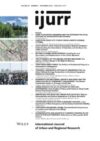The emergence and rapid proliferation of heritage urbanism continues to facilitate processes of tourism-led housing commodification across the world today. Consequently, increasing volumes of visitors continue to pour into the world’s primary tourist cities and regions, leading to experiences of ‘over-tourism’ across many socio-spatial contexts, worsening congestion at and surrounding tourist sites, growing discontent among local residents, and displacement pressures due to associated processes of transnational gentrification. This study examines these consequences as contemporary manifestations of the contradictory dynamics associated with the pursuit of cultural monopoly rent in one globally recognized and growing tourist destination: Kyoto, Japan. In the process, the study chronicles the creative socio-spatial strategies adopted by the City of Kyoto in response to these contradictions, further nuancing our knowledge of processes of tourism-led housing commodification. Preserving the city’s historic and cultural resources, upon which the pursuit of cultural monopoly is based, has involved a carefully calculated degree of (de)commodification in the city’s residential and commercial property sectors. The pursuit of cultural monopoly rent is highlighted as both the end goal and the primary means of simultaneously exploiting and preserving the city’s ostensibly unique attributes.
Details
Written by:
Matthew B. Anderson
Digital Object Identifier (DOI)
https://doi.org/10.1111/1468-2427.13368
About DOI
